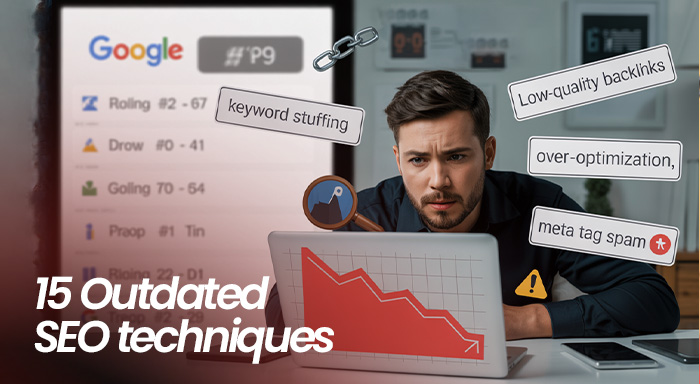In the rapidly evolving world of digitalization, search engines regularly update their SEO guidelines to detect spam and ensure a better user experience. Modern SEO techniques are guided by advanced
In the rapidly evolving world of digitalization, search engines regularly update their SEO guidelines to detect spam and ensure a better user experience. Modern SEO techniques are guided by advanced machine learning algorithms and Natural Language Processing (NLP) abilities. Employing outdated SEO techniques can have a derogatory impact on your site’s rankings and visibility. Relying on outdated SEO practices can derail even the best content strategy in 2025.
In this blog, we have discussed the 15 outdated SEO practices that you must avoid for optimum results.
What Are Outdated SEO Practices?
Previously beneficial optimization techniques have now been rendered ineffective by modern search engines and their AI-driven algorithms. These practices were designed to manipulate the search engine rankings through a superficial approach and often violate the current webmaster guidelines. Nowadays, these techniques do more harm than good, making it crucial for professionals to shift their focus towards a quality-based approach.
Outdated SEO Practices to Avoid
1. Keyword Stuffing and Over-Optimization
Keyword stuffing is the practice of repetitive use of keywords in the content without adding to its value. It is one of the most notable outdated SEO practices. The optimum keyword density has been reduced to 1-1.5% with a focus on organic integration instead of unnatural cramming. Modern SEO algorithms can detect the misuse of keywords and penalize it.
Avoid inserting keywords into every available paragraph and space. Naturally incorporated keywords enhance the readability of the content for a better user experience.
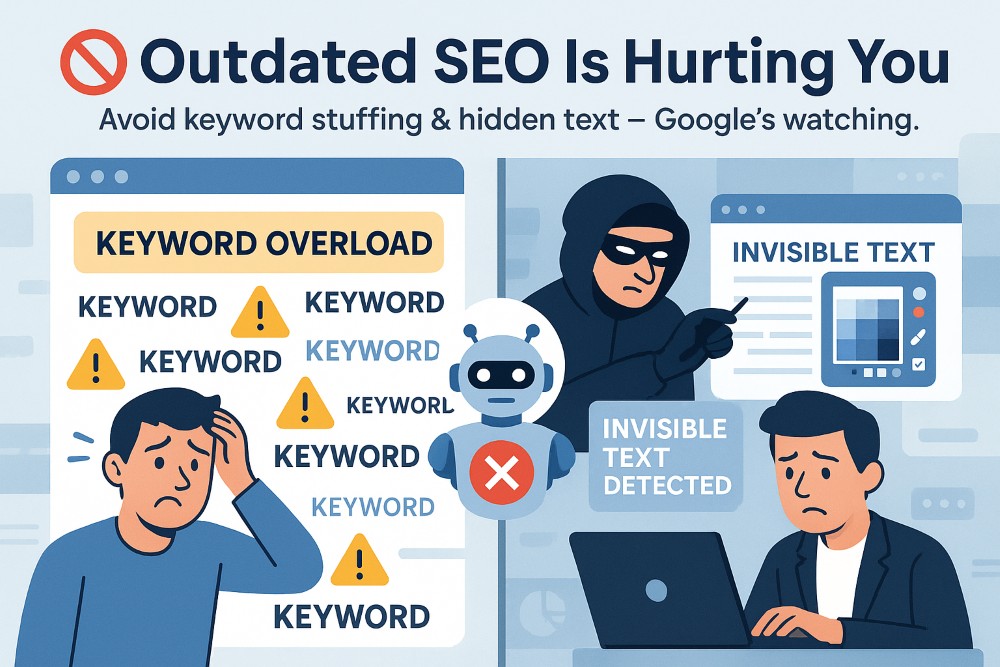
2. Hidden Invisible Keywords
Many professionals hide the keywords by changing the color of the font to match the background, making them invisible. Additional keywords can be incorporated into the content using these practices with no effect on the visual appeal.
Modern search engine crawlers (specialized search engine algorithms) can identify these hidden keywords that can result in penalties or deindexing of affected pages.
3. Spammy and Low-Quality Link Networks
Building spammy backlinks is among the most damaging outdated SEO practices, as search engines now focus on link quality. Artificial link networking schemes intended to manipulate PageRank and authority signals can now be screened and filtered by SEO algorithms. This results in manual penalties that can lower the website’s ranking credibility.
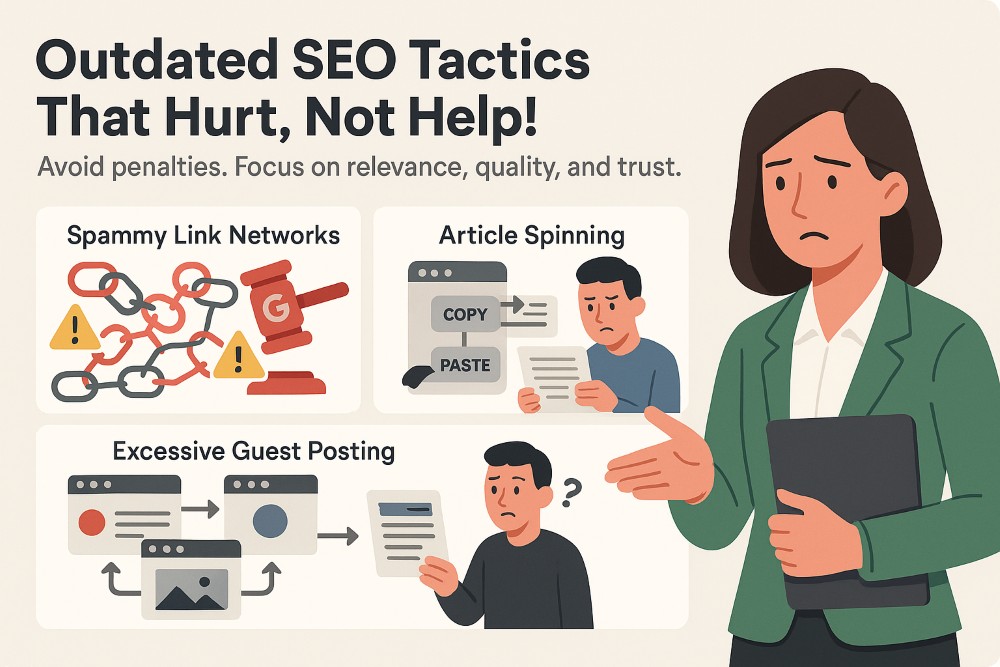
4. Article Spinning and Duplicate Content
Article spinning is the process of generating multiple versions of the same content using spinning tools. These duplicate articles reuse the same information and are generated with a ‘quantity over quality’ approach with no additional value to the users.
Modern search engine algorithms prioritize original and authentic content that aligns with the intent of the users’ queries to provide relevant information.
5. Excessive Guest Posting and Link Exchanges – An Outdated SEO Practice if Misused
Guest posting is a very successful SEO technique that encourages link reciprocation for mutual benefits. However, excessive backlinking to unrelated websites that do not cater to the users’ interests is discouraged. Nowadays, SEO algorithms screen domains or links to filter out content that drives traffic towards genuine websites.
Adding niche-specific links (borne out of genuine relationships) that are relevant to the users’ interests can build trust, enhance user experience, and improve conversion rates.
6. Meta Tag Keyword Optimization
Modern search engines focus on aligning their SERP (Search Engine Result Pages) results to the intent of the query rather than the exact keyword match. Hence, optimizing the meta tag to incorporate keywords provides no SEO value.
You can write catchy meta tags that clearly convey the intent of your content. Divert your efforts towards the optimization of title tags, meta descriptions, and header tags that influence user engagement.
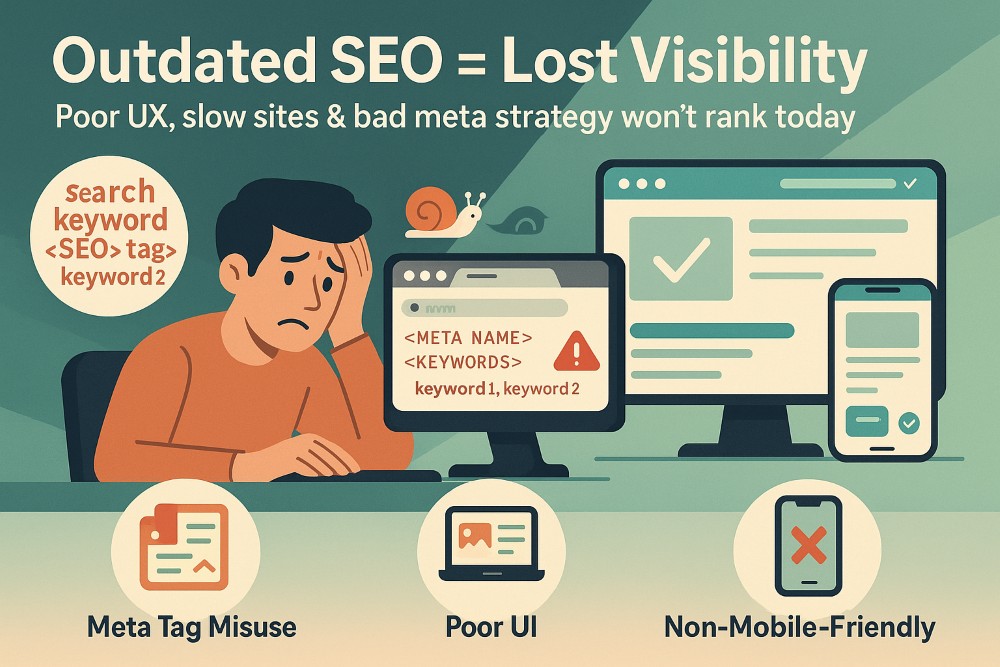
7. Low-Performance Website and UI Designing
Low-performing websites with slow loading speed and high response time can contribute to poor user experience. Search engines can lower the ranking of the websites that the crawlers (search engine algorithms) find difficult to access and navigate.
Responsive, well-structured, and user-friendly interfaces that enable seamless experiences are preferred by the modern search engines compared to the outdated Flash implementations.
8. Ignoring Platform-Friendly Optimization
The last decade witnessed a steep rise in the use of mobile phones, tablets, and other smart devices. Today, most of the search requests are made on these devices. Therefore, modern search engines now prioritize platform-friendly optimization over desktop-only websites.
This ensures that your content is easily accessible to the users, adding to their convenience.
9. Doorway and Gateway Pages
Previously, thin, low-quality pages were created to optimize the website for specific keywords. Such pages exist only to divert the traffic to other content with no additional value to the current query. These pages can be penalized by modern SEO algorithms that do not index them.
Avoid using doorway tactics and build landing pages with quality content. This not only increases the website traffic rates but also improves the time spent by users on your website.
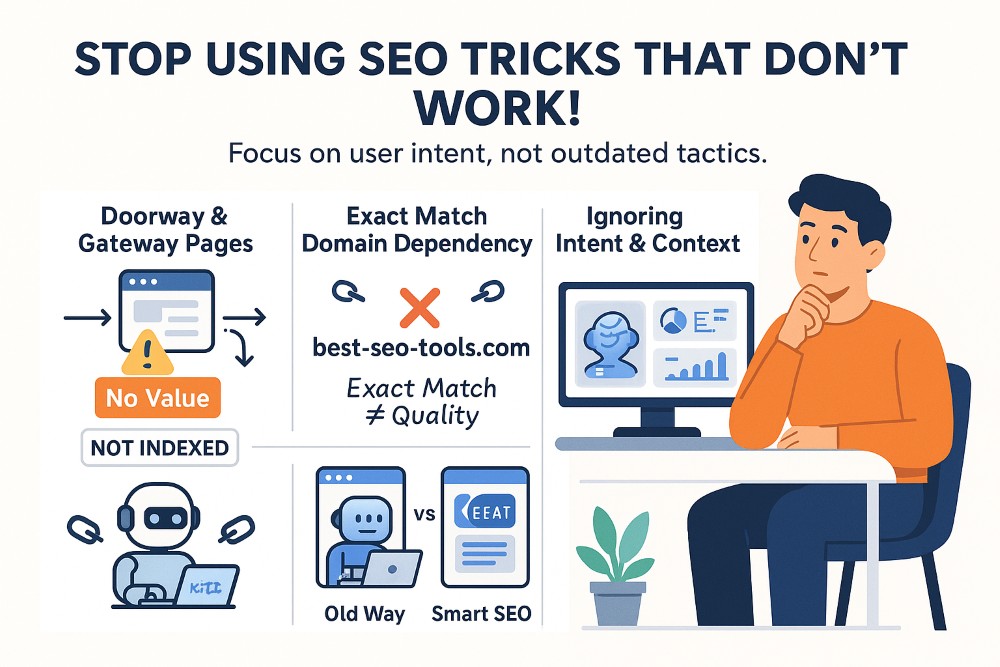
10. Exact Match Domain Dependency
Relying solely on EMDs is a textbook example of outdated SEO practices that ignore content quality and user intent. Exact Match Domains (EMDs) are links that contain the exact keyword within the domain name irrespective of the quality of the link. Though effective in the past, this is no longer beneficial, as it does not compensate for low-quality or weak links.
Modern algorithms focus on the overall authenticity, credibility, and relevance of the content.
11. Ignoring Intent and Context Optimisation
There has been a shift in the approach from search engine-first content to people-first content with increased emphasis on EEAT, which stands for
- E – Experience
- E – Expertise
- A – Authoritativeness
- T – Trustworthiness
AI integration and NLP capabilities have granted context awareness powers to modern SEO algorithms. AI-driven semantic analytics provides insights into the intent behind the query so that the context of the displayed content suggestions on the SERPs can accurately align with the intent.
When researching keywords, also get an understanding about the intent behind the trending queries and produce content that best addresses them.
12. AI-generated Content
Content written by AI can sound robotic and contain false information, ruining user experience. Search engines prefer human-written and original content. Modern SEO algorithms conduct AI-powered analysis to identify recurring patterns that indicate low-quality AI-written content.
Upload well-researched, human-written content to improve engagement and increase revenues.

13. Ignoring Page Loading Speed
Pages that load in under 5s report a higher percentage of returning users compared to slow-loading web pages. Overlooking website performance can lead to lower rankings, diminished user experience, and increased bounce rates.
Optimize the core web vitals, minimize HTTP requests, and implement caching strategies for faster loading pages across all devices.
14. Social Media Spam
Fake social media profiles or paid followers can damage brand reputations. Trustworthiness is essential for good SEO rankings. Modern SEO algorithms can detect fake social media metrics.
It is advisable to establish a sustainable social media presence through authentic engagement and community-building practices.
15. Text-Only Content
The AI-driven SEO algorithms have multi-modal search and analysis capabilities that can process content in different formats. Search engines now prefer content integrated with images, infographics, videos, and other interactive elements that can help users gain a better understanding of the topic.
👉Why Avoid Outdated SEO Practices in 2025?
Using outdated SEO practices can result in lower SERP rankings, penalties, and a loss of organic traffic. These old tactics no longer align with how modern search engines rank content. Staying informed about outdated SEO practices ensures your site remains compliant and competitive.
Best Modern SEO Practices
Some of the modern SEO practices that can be implemented to align with the latest SEO techniques are
- Optimizing the Core Web Vitals—Loading speed and UI of your website can be improved.
- Intent-Based Content—Generate content that addresses the users’ queries accurately.
- Strengthen EEAT metrics—When creating content, emphasize EEAT factors.
- Structure the Content—Well-structured content with proper titles, headlines, and sub-headlines is easier for the algorithms to crawl through.
If you use AI SEO tools for scaling, ensure that the automations align with the updated guidelines for efficient results. Additionally, leveraging “guest post” and “write for us” opportunity helps you build high quality backlinks from authoritative sources. This not only improves domain authority and fuel referral traffic, but it also helps your brand become renowned in their specific niche.
Conclusion
Emerging trends indicate a shift towards a user-centric approach where the focus is on providing a better user experience. The rapid advancement of search engine algorithms, in alignment with this, demands dynamic upgrades in the SEO techniques. Outdated SEO practices can damage your website’s ranking and devolve the progress that you have made. To stay ahead of the competition, it is essential to avoid these practices and adopt the modern techniques. Improve your rankings, enhance user experience, and drive up traffic rates with the best SEO practices that align with the modern SEO guidelines.
👉To thrive in 2025, avoid outdated SEO practices and embrace methods that enhance user experience and follow Google’s evolving algorithms.
Respond to this article with emojis



